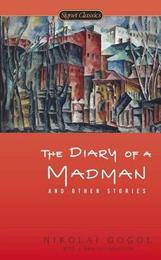
|
The Diary of a Madman and Other Stories
Paperback / softback
Main Details
| Title |
The Diary of a Madman and Other Stories
|
| Authors and Contributors |
By (author) Nikolai Gogol
|
|
Introduction by Donald Fanger
|
|
Afterword by Priscilla Meyer
|
| Physical Properties |
| Format:Paperback / softback | | Pages:256 | | Dimensions(mm): Height 171,Width 106 |
|
| Category/Genre | Classic fiction (pre c 1945)
Short stories |
|---|
| ISBN/Barcode |
9780451418562
|
| Classifications | Dewey:FIC |
|---|
| Audience | |
|---|
|
Publishing Details |
| Publisher |
Penguin Putnam Inc
|
| Imprint |
Signet Classics
|
| Publication Date |
5 March 2013 |
| Publication Country |
United States
|
Description
Some call him a Russian Mark Twain. And with his special blend of comedy, social commentary, and fantasy, Nikolai Gogol paved the way for his countrymen Tolstoy and Dostoyevsky. Some call him a Russian Mark Twain. And with his special blend of comedy, social commentary, and fantasy, Nikolai Gogol paved the way for his countrymen Tolstoy and Dostoyevsky. This sampling of Gogol's works includes the increasingly fantastic entries of "The Diary of a Madman," followed by the wonderfully surrealistic "The Nose," in which the title character embarks on some unlikely activities when separated from its owner's face. In "The Carriage," a pompous landowner gets his comeuppance when he attempts to impress a general. Rounding out the collection are the woefully comic tale of a clerk's acquisition of "The Overcoat" and the celebrated novella "Taras Bulba" about the Ukrainian mythic hero said to have led a bloody Cossack revolt against the Poles. Translated by Priscilla Meyer and Andrew R. McAndrew With a New Introduction and an Afterword by Priscilla Meyer
Author Biography
The son of a small landowner, Nikolai Gogol (1809-52) was educated at the Niezhin gymnasium, where he started a magazine and acted in student theatricals. In 1828, he went to St. Petersburg, obtained a government clerkship, and devoted himself to writing. In 1831-32, he published two volumes of Evenings on a Farm Near Dikanka, a collection of stories based on Ukrainian folklore that was enthusiastically received. He next planned to write a history of Russia in the Middle Ages. The work never materialized, but the planning of it served to win him a chair of history at the University of St. Petersburg. Meanwhile, he published "Taras Bulba" and a number of short stories, including "The Overcoat." On April 19, 1836, his famous comedy The Inspector General was produced. The play stirred up controversy and critics hailed its author as the head of the Naturalist school. Gogol spent the next twelve years abroad, living mainly in Rome. During his voluntary exile, he completed Dead Souls, a panorama of Russian life. Published in 1842, the book was an immediate success. The next ten years Gogol spent writing and rewriting a sequel that was never to see publication. Andrew R. MacAndrew is the translator of numerous books, including Notes from Underground and The Brothers Karamazov by Fyodor Dostoyevsky, Gogol's The Inspector General, and Selected Letters of Fyodor Dostoyevsky. Priscilla Meyer is Professor of Russian Language and Literature at Wesleyan University, She published the first monograph on Vladimir Nabokov's Pale Fire, Find What the Sailor Has Hidden, and edited Andrei Bitov's collected stories, Life in Windy Weather. She is coeditor of collections on Gogol, Dostoevsky, and Nabokov. Her most recent book is How the Russians Read the French- Lermontov, Dostoyevsky, Tolstoy.
Reviews"The greatest artist that Russia has yet produced."-Vladimir Nabokov "Behind his laughter you feel the unseen tears." -Alexander Pushkin
|